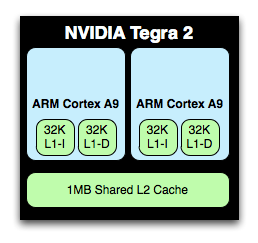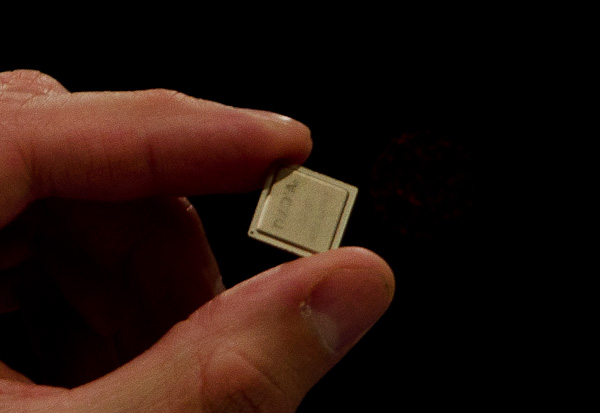NVIDIA's Project Kal-El: Quad-Core A9s Coming to Smartphones/Tablets This Year
by Anand Lal Shimpi on February 15, 2011 9:05 PM ESTThe Architecture
Kal-El looks a lot like NVIDIA's Tegra 2, just with more cores and some pin pointed redesigns. The architecture will first ship in a quad-core, 40nm version. These aren't NVIDIA designed CPU cores, but rather four ARM Cortex A9s running at some presently unannounced clock speed. I asked NVIDIA if both the tablet and smartphone versions of Kal-El will feature four cores. The plan is for that to be the case, at least initially. NVIDIA expects high end smartphones manufacturers to want to integrate four cores this year and going in to 2012.

The CPU cores themselves have changed a little bit. Today NVIDIA's Tegra 2 features two Cortex A9s behind a shared 1MB L2 cache. Kal-El will use four Cortex A9s behind the same shared 1MB L2 cache.
NVIDIA also chose not to implement ARM's Media Processing Engine (MPE) with NEON support in Tegra 2. It has since added in MPE to each of the cores in Kal-El. You may remember that MPE/NEON support is one of the primary differences between TI's OMAP 4 and NVIDIA's Tegra 2. As of Kal-El, it's no longer a difference.

Surprisingly enough, the memory controller is still a single 32-bit wide LPDDR2 controller. NVIDIA believes that even a pair of Cortex A9s can not fully saturate a single 32-bit LPDDR2 channel and anything wider is a waste of power at this point. NVIDIA also said that effective/usable memory bandwidth will nearly double with Kal-El vs. Tegra 2. Some of this doubling in bandwidth will come from faster LPDDR2 (perhaps up to 1066?) while the rest will come as a result of some changes NVIDIA made to the memory controller itself.
Power consumption is an important aspect of Kal-El and Kal-El is expected to require, given the same workload, no more power than Tegra 2. Whether it's two fully loaded cores or one fully loaded and one partially loaded core, NVIDIA believes there isn't a single example of a situation where equal work is being done and Kal-El isn't lower power than Tegra 2. Obviously if you tax all four cores you'll likely have worse battery life than with a dual-core Tegra 2 platform, but given equal work you should see battery life that's equal if not better than a Tegra 2 device of similar specs. Given that we're still talking about a 40nm chip, this is a pretty big claim. NVIDIA told me that some of the power savings in Kal-El are simply due to learnings it had in the design of Tegra 2, while some of it is due to some pretty significant architectural discoveries. I couldn't get any more information than that.

Kal-El vs. Tegra 2 running 3D game content today at 2 - 2.5x the frame rate
On the GPU side, Kal-El implements a larger/faster version of the ULP GeForce GPU used in Tegra 2. It's still not a unified shader architecture, but NVIDIA has upped the core count from 8 to 12. Note that in Tegra 2 the 8 cores refer to 4 vertex shaders and 4 pixel shaders. It's not clear how the 12 will be divided in Kal-El but it may not be an equal scaling to 6+6.
The GPU clock will also be increased, although it's unclear to what level.
The combination of the larger GPU and the four, larger A9 cores (MPE is not an insignificant impact on die area) results in an obviously larger SoC. NVIDIA measures the package of the AP30 (the smartphone version of Kal-El) at 14mm x 14mm. The die size is somewhere around 80mm^2, up from ~49mm^2 with Tegra 2.











76 Comments
View All Comments
B3an - Wednesday, February 16, 2011 - link
Android 2.3 finally, FINALLY has GPU acceleration. So the Samsung Galaxy S2 will have it for instance.I totally agree with you though, Google should have had GPU acceleration a long time ago, most people i know who have iPhones complain about the choppiness of Android when scrolling/animating.
Windows Phone 7 actually has the smoothest OS of them all though, it's so well polished. MS done it literally perfectly on the first release. Android takes many versions to fix this, and it's still not as good, but atleast GPU acceleration is there now.
Lucian Armasu - Wednesday, February 16, 2011 - link
Only Honeycomb has full hardware acceleration. Android 2.3 has better garbage collection that has improved the speed of the UI a bit.AbRASiON - Wednesday, February 16, 2011 - link
Someone listen to this guy!I love my Android phone but god damnit even a half decent one is a little laggy and sluggish at points.
The iphone sucks in a lot of silly ways but it's always a smooth and consistent feel, even if it fakes it - they are clever about it.
BlueScreenJunky - Wednesday, February 16, 2011 - link
Well according to the sales figures that doesn't prevent Android phones from selling well so I don't see a problem from Google and the manufacturers' point of view.And from my point of view that's absolutely no problem at all : Since I like my phone to be responsive and I dont need 50 widgets I only have one home screen (So I can't swipe through anything) and I disabled every single animation using spareparts...
So there's nothing left to accelerate really and now when I use a phone with the animations enabled I'm like "Why do I have to look at the page sliding or zooming in before I can actually begin to read ? It's just a waste of time !"
Aloonatic - Monday, February 21, 2011 - link
I guess you just eat protein and vitamin pills etc? What's the point in making tasty food and chewing it? It's just a waste of time.I guess it's good that you are happy to live in a bland little world, but most people aren't and whether you realise that it's an issue or not, but one of the reasons why many people love LOVE (LOVE!!!!!) their Apple devices, and why they still have a strong presence in the market in spite of their price premium is because they have realised that the swoop, expanding, sliding animations make using their devices a far more fun experience, rather than just being a dull utilitarian device.
You might be happy with what you have, but I think you're in a teeny, tiny minority when the entire market (ie not just techies) is taken into account and that's where the money is to be made. Expect Android and WinMo to try to emulate Apple as much as possible, because if they don't, they will always struggle to lure people, their wallets and their personal data that they might want to mine, away from Apple.
softdrinkviking - Wednesday, February 16, 2011 - link
If extra cores make browsing buttery-smooth, I'm all for it.They shouldn't be drawing extra power from your phone unless they are getting some tangible use anyway. (that is assuming some level of power-gating)
I like GPU acceleration too, but there is no reason to ditch a wider architecture because it's effects are not immediately discernible by people browsing phones in the verizon store.
tviceman - Tuesday, February 15, 2011 - link
The similarities with Nvidia's first products are strikingly similar to it's venture into the mobile space. Insofar as being a success,Tegra1 = NV1 (not successful at all)
Tegra2 looks like it has become the RIVA 128 - huge turn around and very competitive.
Tegra3 (Kal-El) could end up being the RIVA TNT/ TNT2 and the transition to 28nm (probably Wayne) could propel Nvidia to being the #1 mobile CPU manufacturer ---- much like what GeForce did for Nvidia.
djgandy - Wednesday, February 16, 2011 - link
Well they haven't sold anything yet. It's business as usual at Nvidia, delivering lots of hype and marketing.Considering they struggle to keep their desktop parts running cool and with low power, maybe people should focus on the key aspect of a mobile chip, battery life, rather than salivating over cherry picked CPU benchmarks and potential GPU performance which is already out there in pocket melting form.
bplewis24 - Wednesday, February 16, 2011 - link
They already have an article discussing Tegra2's battery life performance.Brandon
tim851 - Tuesday, February 15, 2011 - link
What does Nicolas Cage's son have to do with all of this?